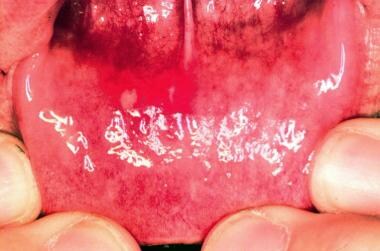Practice Essentials
Hand-foot-and-mouth disease (HFMD) is an acute viral illness that presents as a vesicular eruption in the mouth, but it also can involve the hands, feet, buttocks, and/or genitalia. Hand-foot-and-mouth disease is common and potentially but infrequently fatal in children younger than 5 years. [1] Coxsackievirus A type 16 (CVA16) is the etiologic agent involved in most cases of HFMD, but the illness also is associated with coxsackievirus A5, A7, A9, A10, B2, and B5 strains. Coxsackievirus A6 may have become the commonest enterovirus in seasonal outbreaks of hand-foot-and-mouth disease in children in France and Finland. [2]
Enterovirus 71 (EV-71) has caused outbreaks of HFMD with associated neurologic involvement in the western Pacific region and Southeast Asia.
See Clues in the Oral Cavity: Are You Missing the Diagnosis?, a Critical Images slideshow, to help identify the causes of abnormalities of the oral cavity.
Also, see the 15 Rashes You Need to Know: Common Dermatologic Diagnoses slideshow to help identify and treat various rashes and the 15 Back-to-School Illnesses You Should Know slideshow to help identify conditions that may occur in young patients after they return to the classroom.
Signs and symptoms
The history in patients with HFMD is as follows:
-
Sore mouth or throat
Background
Hand-foot-and-mouth disease (HFMD) is an acute viral illness first evident as a vesicular eruption in the mouth. HFMD can also involve the hands, feet, buttocks, and/or genitalia. Coxsackievirus A type 16 (CV A16) is the etiologic agent involved in most cases of HFMD, but the illness is also associated with coxsackievirus A5, A7, A9, A10, B2, and B5 strains. Coxsackievirus A6 may have become the commonest enterovirus in seasonal outbreaks of hand-foot-and-mouth disease in children in parts of Europe. [2]
Enterovirus 71 (EV-71) has also caused outbreaks of HFMD with associated neurologic involvement in the western Pacific region and Southeast Asia.
Pathophysiology
Infection generally occurs via the fecal-oral route or via contact with skin lesions and oral secretions. Viremia develops, followed by invasion of the skin and mucous membranes. Widespread apoptosis likely results in the characteristic lesion formation.
Frequency
United States
Epidemics of HFMD generally occur in the summer to early fall months, although cases can occur sporadically all year.
International
Hand-foot-and-mouth disease (HFMD) has become a societal burden in parts of Asia with pandemic potential [9] , particularly in Vietnam. [10] HFMD epidemics associated with EV-71 have been more frequent in Southeast Asia in recent years, including the Republic of China (1998) and Singapore (2000). Risk factors in these epidemics include attendance at childcare centers, contact with HFMD, large family number, and rural residence. [11] Seasonal trends and climate factors may be evident and were delineated in Guangzhou (Canton) China. [1] The incidence of HFMD is increasing despite current preventive efforts in Singapore. [12]
Mortality/Morbidity
Hand-foot-and-mouth disease caused by coxsackievirus is generally a mild self-limited illness that resolves in 7-10 days; rarely, HFMD may recur or persist. Serious complications also are rare.
Severe oral ulcerations can create painful stomatitis. This may interfere with oral intake and cause dehydration, the most common complication of HFMD. Rarely, aseptic meningitis accompanies coxsackievirus-induced HFMD.
Hand-foot-and-mouth disease caused by EV-71 has a higher incidence of neurologic involvement, including a poliolike syndrome, aseptic meningitis, encephalitis, encephalomyelitis, acute cerebellar ataxia, acute transverse myelitis, Guillain-Barré syndrome, opsomyoclonus syndrome, and benign intracranial hypertension. These neurologic complications have been attributed to either immunopathology or virus-induced damage to gray matter. [3, 13] There appears to be a strong association between severe illness and coxsackievirus A6 and enterovirus -A71 infections. [10]
Rarely, cardiopulmonary complications such as myocarditis, interstitial pneumonitis, and pulmonary edema may occur. Neurologic involvement with sequelae is less likely to occur in patients with HFMD caused by coxsackievirus strains than with HFMD caused by EV-71. Chang et al analyzed the Taiwan HFMD epidemic of 1998 and revealed that 68% of the EV-71 cases were uncomplicated. [14] Thirty-two percent of the cases had complications; 7.3% involved aseptic meningitis, 10% involved encephalitis, 2.3% involved poliolike syndrome, 4.5% involved encephalomyelitis, and 6.8% involved fatal pulmonary edema (7.9% of patients died and 4% of patients had sequelae). In the coxsackievirus A16 group, 94% of the cases of were uncomplicated; only 6.3% cases were complicated by aseptic meningitis; no fatalities or sequelae were reported.
Chong et al observed vomiting, leukocytosis, and an absence of mouth ulcers as predictive risk factors for fatal cases of EV-71 HFMD during the Singapore epidemic in 2000. [4]
Sex
Most reports indicate that HFMD has no sexual predilection. Some epidemic data observe a slight male-to-female predominance ratio of 1.2-1.3:1.
Age
Children younger than 10 years are most commonly affected with HFMD; subsequent outbreaks among family members and close contacts may develop. [15]
-
The lower lip has an ulcer with an erythematous halo.


